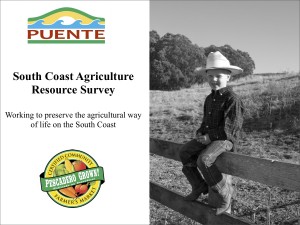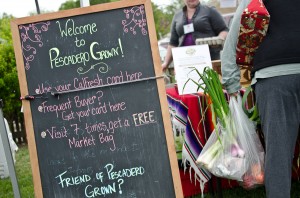
Driving down the San Mateo County coast in springtime, motorists are likely to admire the verdant row crops and fields of grazing cattle that dot the roadside vistas near Pescadero. Few people know the South Coast’s sad little secret: finding land to farm and live on is so expensive that the lifestyle itself is in peril.
That’s what South Coast farmers and ranchers told Puente in response to a recent South Coast Agriculture Survey. Puente sought to identify ways it could help sustain food production and support a farm-based economy, the most important industry on the coast.
More than 50% of farmers in the area are first-time food producers, according to the survey. They quickly discover the struggle to hold on to valuable farmland. Property values reflect the greater Silicon Valley market, pushing land values into the range of $3 million for just a few acres of ranchland real estate. Buying is out of the question, so some operations lease their land from private owners or open space preservation groups like Midpeninsula Regional Open Space District or Peninsula Open Space Trust (POST).
But finding an affordable, long-term lease is one of the biggest challenges on the coast. Of 43 survey respondents (out of 120 surveyed), 75 percent said leases are not long-term enough, which acts as a disincentive to stay and invest in the land.
“How can we pass along our ranching opportunity to our kids? We need longevity. After all the work we’ve put in, we’d like to pass the lease on to our kids,” says Doniga Markegard, who owns Markegard Family Grass-Fed with her husband, Erik. Markegard conducted the agriculture survey for Puente and says many farming and ranching families have the same concerns.
The family raises grass-fed beef, lamb, pastured pork and free-range chicken eggs on a 3,000-acre rolling coastal range above San Gregorio. They rent the land, and the house, from POST. But the lease is short-term. Other farmers fear the land they lease may be sold.
This is where Puente has identified one of the biggest opportunities to help build relationships. Overwhelmingly, the agricultural community responded to the survey by asking Puente to help keep farming alive on the South Coast – a process Puente kicked off at its weekly Pescadero Grown! farmer’s markets. Now local food producers are looking to Puente to help with other challenges, such as the fact that rental housing is so expensive that it makes it impossible for farmers to live on their own land.
“The connection that Puente makes between food, farmers and farm workers is essential to the survival of the economy on the South Coast,” says Puente Executive Director Kerry Lobel. “The Farmer’s Market is the biggest step so far, but only the first one.”

Puente put local farmers on the map last year – literally – by creating the area’s first Foodshed Map, thanks to Doniga Markegard. Puente connects farmers with farm workers looking for jobs. It helps bridge the language gap between managers and workers with its Spanish classes for English speakers, a program popular with the agriculture community. And bilingual Puente youth are on hand at farmer’s markets to help Spanish-speaking customers speak to vendors.
Going forward, Puente sees a new role for itself to help form mutually beneficial relationships between landowners and the agricultural community. Puente is thinking about hosting a land-linking mixer and will encourage open space agencies like POST to extend long-term leases to tenants.
San Mateo County Supervisor Don Horsley’s office, which includes the South Coast, is hard at work trying to make it easier for farmers and ranchers to build farm labor housing on their own land by addressing sticky permit issues and problems like the need for new septic tanks.
Horsley also wants to repair deterioriating farm worker housing, which often dates back to the 1960s or earlier. He has asked the Housing Department to set aside money for a low-interest loan program to give owners an incentive to update their housing stock.
Pescadero’s fertile fields won’t be enough to retain food producers if people are worried about housing and land succession, says Horsley.
“How do we get a new generation to take over and make sure the land stays in row crops and agriculture?” he asks.
To learn more about Pescadero Grown! and Puente’s connection with local farmers, visit www.pescaderogrown.org.


